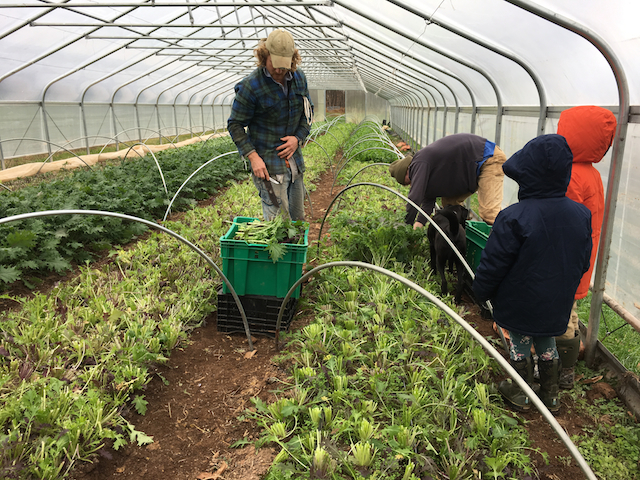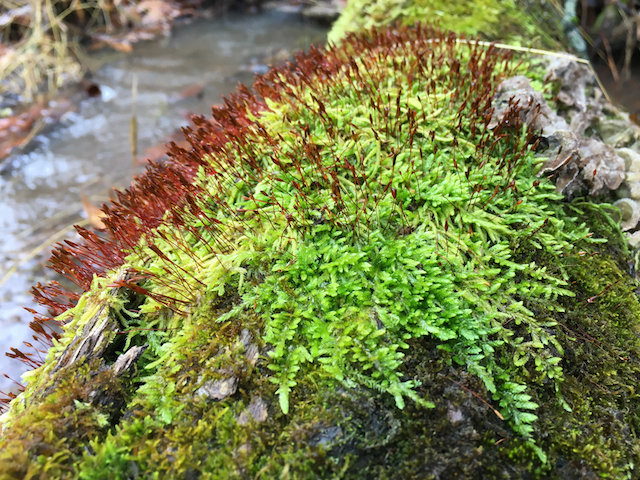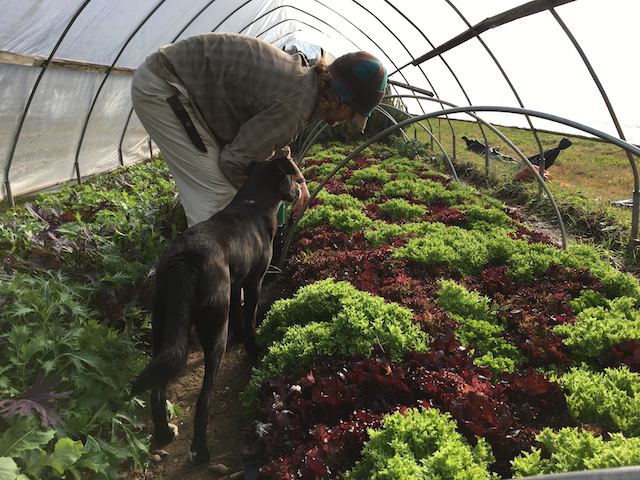
Late Fall Week 4: Cold Balance
News
Expected Harvest
Cold Hardy
by Farmer Dana
Cold Hardy
by Farmer Dana

Harvesting greens mix in the Hoop Tunnel a couple weeks ago.
Late Fall Harvest #4 (Week B) should include cabbage, potatoes, kale, onions, lettuce mix, baby head lettuce, arugula, rosemary, beets, and rutabaga. We aren't 100% certain what the variety and quantity of specific greens will be until we begin harvesting midweek but each week the approximate total weight of fresh greens is 2.5 lbs for Full/Half shares and 1.75 lbs for Medium shares.

Revered Rutabaga
by Linda Dansbury
by Linda Dansbury

Moss (not rutabaga) found in the woods. Moss is a plant that reproduces with spores not flowers. Stalked spore capsules are seen here.
Another new root veggie will be in the pick up room this week - the little known and underappreciated rutabaga!
This sort of dumpy-looking veggie with a purple top and beige bottom, may not look very alluring, but there’s a lot more to this winter vegetable than meets the eye. Underneath its woody-looking exterior, rutabaga’s butter-yellow flesh is sweet and earthy. Rutabagas are the result of turnips crossing with wild cabbages in the 1600s, and while they contain the genes of both veggies, they’re considered a part of the cruciferous family of vegetables (cousins include broccoli) and pack similar health benefits. Just one cup of rutabaga contains approximately 50% of your daily value of vitamin C. They’re also rich in fiber, vitamin B6, potassium, and magnesium — and low in calories. An entire medium-sized rutabaga has only 145.
There are many ways to enjoy rutabaga: Mashed or roasted, either alone or in combination with other root veggies; delicious oven fries - toss in oil of your choice, salt and add herbs and spices you like and bake at about 375 for 30 min or so; slice thin and make into your favorite gratin recipe; instead of using potatoes, make rutabaga Hasselback; add to your favorite soups and stews; add to a mixed root and cabbage roast - yum!
Do you like Carrot Cake? Use rutabaga instead!
Anyway, make sure you add this little known veggie to your winter repertoire!

Notes From The Field
Open/Close
by Farmer Derek
Open/Close
by Farmer Derek

Harvesting lettuce mix in the Hoop House.
Some authentic December weather has arrived. I think I'll enjoy these brisk sunny days and cold clear nights. Thunderstorms and excessive rainfall at the end of November definitely had me yearning for this. With nights descending into the low and mid 20s it means I need to recover the crops in the tunnels with the interior covers to give them an added air pocket buffer. I'll leave the covers on during the day but will at least open the endwall doors of the tunnels for air flow and ventilation and to keep the daytime temperatures from climbing too high. Once lows stay 30 and above I'll remove the covers until the next cold spell.
With the conclusion of November I can now officially tally the rainfall received during the outdoor growing season (March-November). We've been measuring rainfall during that timeframe since 2009. Overall 2020 was our 4th wettest season. It rained 41", 3.5" inches above the 12-year average. The wettest months were July (6.1") and August (6.5"). There were only two months (May, June) with less than 4". Compared to other seasons, it's apparent that we didn't endure any extreme rainfall events or months. There were no 3"+ deluges and only a few times did we receive more than 2". I think this year we were lucky because the trend had been more frequent extreme rainfall events. I'm definitely thankful for the moisture pattern this year. Because of the consistent adequate moisture I didn't have to irrigate any bare ground crops. This season our extreme weather was more temperature related.
The crop plan is well underway. All seeds and plants have been ordered. A few things we're excited about: a new patch of blackberries in a new field will be established; we're going to try to grow rhubarb again; new tomato varieties bred for tunnel production with great heirloom flavors and disease resistance; a production increase in sweet peppers, shishito peppers, butternut squash, and other favorites; a new celery variety that's hopefully more tolerant to leaf curl; utilizing tunnels for early and robust crops in the spring; and much more!


